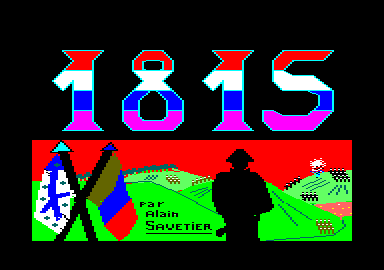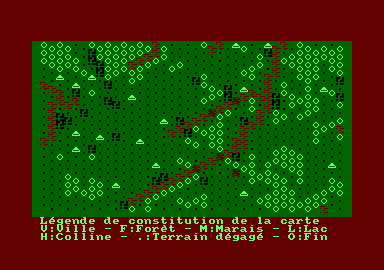Retro Replay Review
Gameplay
1815 delivers a deeply strategic experience rooted in the tactics of the Napoleonic Wars. Each side—greens versus blacks—begins with 25 units drawn from six distinct types, ensuring that every move requires careful consideration. Players must balance the strengths and weaknesses of their units, whether deploying nimble light cavalry to outflank enemy formations or positioning heavy infantry to hold chokepoints created by rivers and groves of trees.
(HEY YOU!! We hope you enjoy! We try not to run ads. So basically, this is a very expensive hobby running this site. Please consider joining us for updates, forums, and more. Network w/ us to make some cash or friends while retro gaming, and you can win some free retro games for posting. Okay, carry on 👍)
The 2D top-down view provides a clear canvas for strategic maneuvering. Terrain features such as rivers, wooded areas, and open fields influence movement and line of sight, forcing commanders to adapt their plans on the fly. For instance, artillery units become far more potent when firing across open ground but must navigate narrow bridges or river fords to reach prime positions, creating tense moments of tactical decision-making.
Replayability is high thanks to the interplay of six unit types and the simple, unforgiving goal: eliminate all enemy forces. Whether you favor bold cavalry charges or methodical artillery barrages, each game unfolds differently based on opening deployments and how you exploit the map’s natural obstacles. The game’s pacing strikes a satisfying balance, with hotly contested skirmishes and larger, slower-moving engagements both feeling rewarding.
Graphics
Visually, 1815 opts for clarity over flash. The green battlefield is rendered in clean, crisp 2D, ensuring that players can instantly identify unit locations and terrain features. Trees appear as clustered circles of darker green, while rivers snake through the field in bright, contrasting blue. This minimalist style keeps the focus firmly on tactical decision-making rather than on elaborate animations.
Unit icons are distinct and intuitive: infantry formed up in lines, cavalry shown as mounted riders, and artillery pieces clearly depicted with cannon silhouettes. Though the animations are modest—units march and wheels turn with simple, frame-by-frame movement—they serve their purpose, conveying each side’s disciplined advance toward engagement without unnecessary visual clutter.
Map obstacles are also easy to read at a glance. Wooded areas provide soft cover markers, and riverbanks are shaded to indicate crossing penalties, making it simple to plan routes and ambushes. The color palette, dominated by varying shades of green and earth tones, is both historically appropriate and visually soothing, allowing long sessions without eye strain.
Story
While 1815 does not unfold through elaborate cutscenes or character-driven narratives, it builds its historical context through concise mission briefings. Each skirmish refers to real divisional movements from the closing days of the Napoleonic Wars, evoking the strategic dilemmas faced by commanders during the climactic battles of 1815.
The absence of a sprawling campaign is offset by scenario-based engagements that challenge players to reenact or even invert famous strategic outcomes. As you marshal your greens or lead the blacks, you become part of a broader historical tapestry, making every decision feel weighted by the stakes of the era.
This focus on pure strategy over storytelling means that your own tactical ingenuity sets the tone. The tension of a well-executed flanking maneuver or the relief of a last-minute river crossing carries its own narrative momentum, ensuring that each match tells a unique story of triumph or defeat.
Overall Experience
1815 stands out as a refined, no-frills war game for players who appreciate pure strategic challenge. Its straightforward ruleset and clear visual presentation lower the barrier to entry, while the depth of unit interactions and terrain considerations keep veteran tacticians engaged. There’s a satisfying sense of mastery as you learn the intricacies of each unit type and leverage the battlefield’s natural features.
The game’s strength lies in its ability to translate historical tactics into an accessible digital form. Whether you’re a history buff eager to reenact Napoleonic maneuvers or a strategy enthusiast seeking a fresh tactical puzzle, 1815 delivers. The quick setup and concise scenarios make it ideal for short sessions, yet the strategic layers ensure that every battle feels meaningful.
Ultimately, 1815 invites players to step into the role of a Napoleonic commander, weighing orders against terrain and force composition. Its balanced blend of simplicity and depth makes it a compelling choice for anyone looking to immerse themselves in one of history’s most pivotal military landscapes.
 Retro Replay Retro Replay gaming reviews, news, emulation, geek stuff and more!
Retro Replay Retro Replay gaming reviews, news, emulation, geek stuff and more!





Reviews
There are no reviews yet.